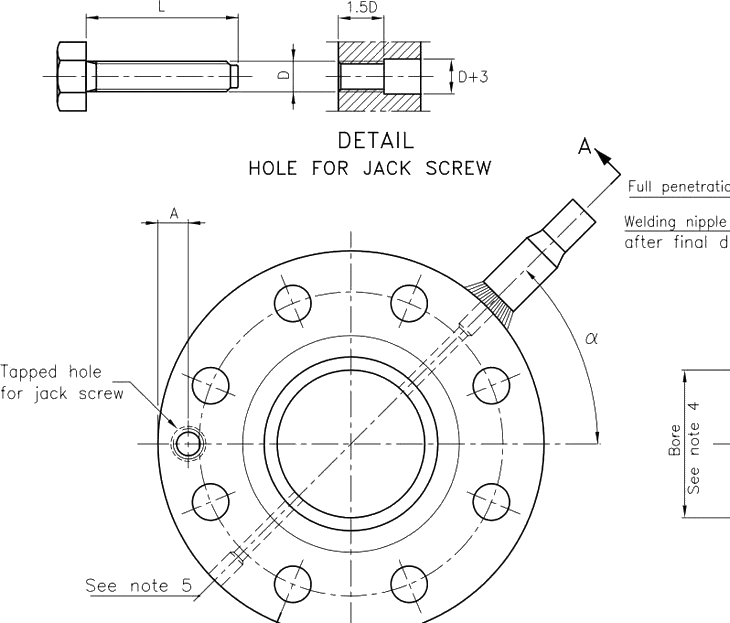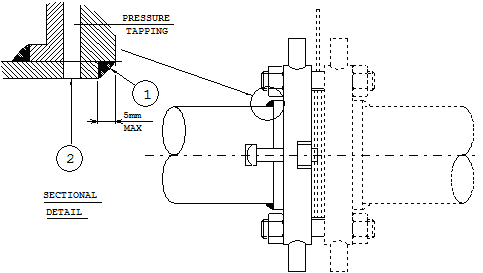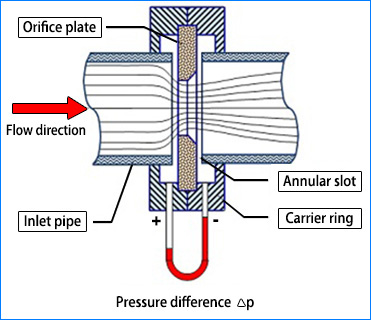Orifice flanges are used instead of the standard pipe flanges when orifice plate or flow nozzle is used. The basic purpose for this is to measuring the flow rate of either gases or liquids in the respective pipeline.
These flanges are used in various industrial applications and are available in various sizes and materials.

Orifice Flange manufacturer Sunny Steel supplies Orifice Flanges, Plate Flanges,
The range of orifice flanges covers all standard sizes and ranges, and all common flange materials. Flanges are available in Welding Neck, Slip On, and Threaded form, and are typically supplied with two 1/2" NPT tappings in each flange.
ASME B16.36 covers Dimensions and dimensional tolerances from orifice flanges (similar to those covered in ASME B16.5) that have orifice pressure differential connections.
Orifice Flanges generally come with either Raised Faces or RTJ (Ring Type Joint) facings. They are, for all intensive purposes, the same as weld neck and slip on flanges with extra machining.

Orifice flange for run installation should be so constructed, machined and attached to the that the inner surface of the passage extends through the orifice flange so that there is no recess at the orifice plate.
The flange bore and the section of pipe shall be of the same internal diameter.
Weldneck and Slip-On Orifice Runs

Weld Neck Orifice Run

Slip-on Orifice Run
1. End of pipe should be reamed after cutting to ensure a perfectly smooth bore and should enter the flange as shown, for raised face flanges. For ring type joints the ends of the pipe should be a maximum of 3 mm from flange face.
2. The pipe should be drilled through each flange pressure tapping using a 12 mm drill for 4” bore pipe and over, a 10 mm drill for 3” bore pipe and a 6 mm drill for 2½” bore pipe and smaller.
Two Orifice Flanges are called an orifice flange union. Each flange comes with two pipe taps for measuring the pressure drop of the flow through an orifice plate.. Orifice plates do not come with the flanges and are sized based on the requirements of the process. Two jack screws are used to spread the flanges apart in order to change the orifice plate. This flange is normally available in weld neck, slip-on, and threaded flanges.

These flanges have a raised face.

Orifice Flanges are installed in a straight run of pipe in order to avoid turbulence at the plate. As a rule of thumb, an orifice flange has ten diameters of straight pipe upstream and five diameters of pipe downstream.
An Orifice Flange is intended for use instead of standard pipe flanges when an orifice plate or flow nozzle must be installed. Pairs of pressure tapings are machined into the Orifice Flange, making separate orifice carriers or tapings in the pipe wall unnecessary. This type of flange includes the orifice plate with data tap, a pair of flanges with integrated taps, a set of gaskets, bolts and nuts and a jackscrew to assist separating the flanges for orifice inspection.
Design can be with RF or RTJ weld neck flanges or RF slip-on flanges. The orifice plates are centered within very close tolerances of the standards.
An Orifice plate is a device used for measuring flow rate. Either a volumetric or mass flow rate may be determined, depending on the calculation associated with the orifice plate. It uses the Bernoulli’s principle which states that there is a relationship between the pressure of the fluid and the velocity of the fluid. When the velocity increases, the pressure decreases and vice versa.
An Orifice plate is a thin plate with a hole in the middle. It is usually placed in a pipe in which fluid flows. When the fluid reaches the orifice plate, the fluid is forced to converge to go through the small hole; the point of maximum convergence actually occurs shortly downstream of the physical orifice, at the so-called vena contracta point As it does so, the velocity and the pressure changes. Beyond the vena contracta, the fluid expands and the velocity and pressure change once again. By measuring the difference in fluid pressure between the normal pipe section and at the vena contracta, the volumetric and mass flow rates can be obtained from Bernoulli’s equation.
When installing the orifice plate flange the pressure taps need to be at the same elevation to each other. The assumption when making the calculation for the orifice plate is that static head of the tubes is the same on both sides of the orifice plate. Pressure taps should not be installed facing down as the taps could become plugged with debris in the line.
Weld Neck Orifice Flanges are butt-welded into the pipeline. The inside diameter (bore diameter) of the pipe should be specified when ordering. Weldneck orifice flanges are available in ANSI classes 300, 600, 900, 1500 and 2500. They are not available in ANSI 150 sizes because the thickness of ANSI 150 flanges are not enough to allow for drilling pressure taps.
Orifice flanges are installed in a straight run of pipe in order to avoid turbulence at the plate. As a rule of thumb, an orifice flange has ten diameters of straight pipe upstream and five diameters of pipe downstream.
 Orifice Flange Union |  Pipe Tap |  Jack Screw |  Pipe Taps |
When installing the orifice plate flange the pressure taps need to be at the same elevation to each other. The assumption when making the calculation for the orifice plate is that static head of the tubes is the same on both sides of the orifice plate. Pressure taps should not be installed facing down as the taps could become plugged with debris in the line.
Weldneck orifice flanges are butt-welded into the pipeline. The inside diameter (bore diameter) of the pipe should be specified when ordering. Weldneck orifice flanges are available in ANSI classes 300, 600, 900, 1500 and 2500. They are not available in ANSI 150 sizes because the thickness of ANSI 150 flanges are not enough to allow for drilling pressure taps.

Orifice flanges are used instead of the standard pipe flanges when orifice plate or flow nozzle is used. The basic purpose for this is to measuring the flow rate of either gases or liquids in the respective pipeline. These flanges are used in various industrial applications and are available in various sizes and materials.
Orifice Flange manufacturer Sunny Steel supplies Orifice Flanges, Plate Flanges, Orifice Plates Fittings in alloy steel, forged steel, ductile iron, Stainless Steel etc.
ASME B1.20.1 covers dimensions and gaging of NPT pipe threads for general purpose applications.
Orifice Flanges cover all standard sizes and ranges, and all common Flange materials

Sunny Steel orifice unions come complete with gaskets, nuts, bolts and jack screws and are made to b16.36 specifications.
Orifice Weld Neck Flanges are used instead of the standard pipe flanges when orifice plate or flow nozzle is used.
It is used for measuring the fluid flow rate in the pipe.
It eliminates drilling and making bores on the pipes for inserting instrumentation probes.
These are cost saving devices to measure flow rate compared to other expensive methods.
Gives accurate readings of flow rate and very reliable.

Tel:
E-mai:
Skype: